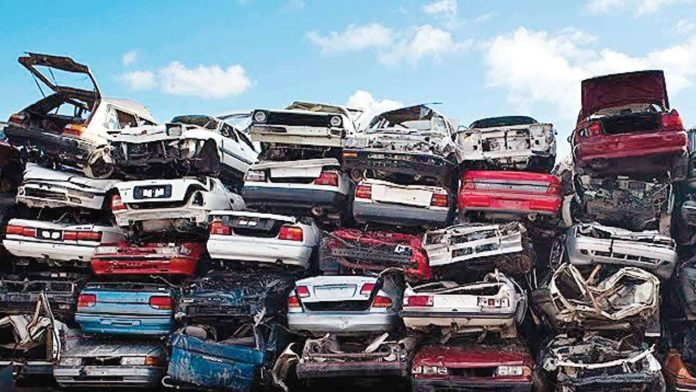Hello Readers!
In today’s blog we will discuss the Vehicle Scrappage Policy launched by Prime Minister Narendra Modi in the Gujarat Investor Summit. To know about the rules, benefits and other important facts of the policy read our blog.
What is Vehicle Scrappage policy?
The scrapping strategy aims to create an ecosystem for phasing out inefficient and polluting vehicles in a safe and environmentally sustainable manner.The initiative aims to develop scrapping infrastructure across the country in the form of automated testing stations and registered vehicle scrapping facilities.
Important Guidelines
Fitness Test:
Old vehicles will have to undergo a fitness test before being re-registered. According to the policy commercial vehicles older than 15 years and private vehicles older than 20 years will be scrapped.Old vehicles will be examined at an authorised Automated Fitness Center rather than being discarded solely because of their age.
Vehicles that fail the fitness test will be discarded. Emission tests, braking systems, and safety components will be checked.If the old vehicle passes the test, the owner can continue to use it, but it will have to repeat the same after every five years.
Which vehicles will be scrapped?
Vehicles will not be discarded only because of their age under the new policy. They will be scientifically tested through authorised, automated testing centres, as previously stated. Unfit automobiles will be scrapped in a scientific manner, ensuring that all registered vehicle scrapping facilities across the country are technologically advanced and transparent.
Cars that fail a fitness test include those that have been damaged by fire, riot, natural disaster, accident, or any other misfortune; vehicles that have been declared obsolete or beyond repair; and vehicles that have outlived their utility. If a vehicle fails the fitness test, it is considered unfit for roads, and its registration certificate will not be renewed.
If the appellate authority orders it, one retest will be allowed after the required repair, rectification, and re-inspection. If the vehicle fails the re-test as well, it will be regarded as an end-of-life vehicle (ELV).
Incentives offered on scrapping
Road Tax Rebate –
Rebate on purchase of new vehicles – Road-tax rebate of up to 25% for personal vehicles and up to 15% for commercial vehicles will be given to owners of old vehicles to scrap old and unfit vehicles.
Vehicle Discount –
Vehicle manufacturers will also give a discount of 5% to people who will produce the ‘Scrapping Certificate’. The incentives include scrap value for the old vehicle, which will be approximately 4-6% of the ex-showroom price of a new vehicle
Registration Fees-
Registration fees will be waived off on the purchase of a new vehicle.
Disincentives
If the old car passes the test, the owner can keep driving it, but reregistration fees will be substantially higher. The cost of renewing a fitness certificate may increase by 62 times for commercial vehicles and 8 times for individual automobiles.
Significance
Employment – 35 thousand people would be employed in the new fitness centres, and an investment of Rs 10,000 crores will be pumped in.
Hub for Vehicle Scrapping – It will result in the establishment of more scrap yards across the country, as well as the efficient recovery of waste from old vehicles. The policy aims to build scrapping infrastructure in the form of Registered Vehicle Scrapping Facilities and Automated Testing Stations in India.
Reduced cost of production – The scrappage policy is likely to reduce raw material costs by around 40% which will lead to reduction in prices and higher sales. The policy will reduce India’s dependency on scrap steel (about worth 22,000 crore) which is imported from the foreign market.
Improved Revenue – The government is expected to get around 30,000 – 40,000 crores through Goods and Services Tax (GST) from this policy.
It will also boost sales of heavy and medium commercial vehicles that have suffered due to economic slowdown in the pandemic.
Reduce Pollution – It will play a significant part in modernising the vehicular population by assisting in the phase-out of unfit and polluting cars across the country, as well as promoting a circular economy and a waste-to-wealth campaign.
Older vehicles harm the environment 10 to 12 times more than newer vehicles. India has around 1.7 million vehicles that are older than 15 year but do not have a fitness certificate.
The rule will not be applicable to vintage cars. The tentative date for the implementation of the policy is October 1, 2021. Meanwhile, scrapping of government and PSU vehicles above 15 years will be undertaken from April 1, 2022.
Circular Economy
It is an economy in which things are built for long-term use, reuse, and recycling, and practically everything is reused, remanufactured, and recycled into raw materials or utilised as a source of energy.
It comprises the three R’s (Reduce, Reuse, and Recycle), as well as material refurbishment, recovery, and repair. India has a huge potential for reuse and recycling as only around 20% of the total waste generated goes into the recycling process.
To summarise, the policy will help India strengthen the country’s road safety and create employment , reduce vehicular pollution, and contribute to India’s efforts towards achieving its climate goals.
Stay tuned with hranker.com for more updates!




